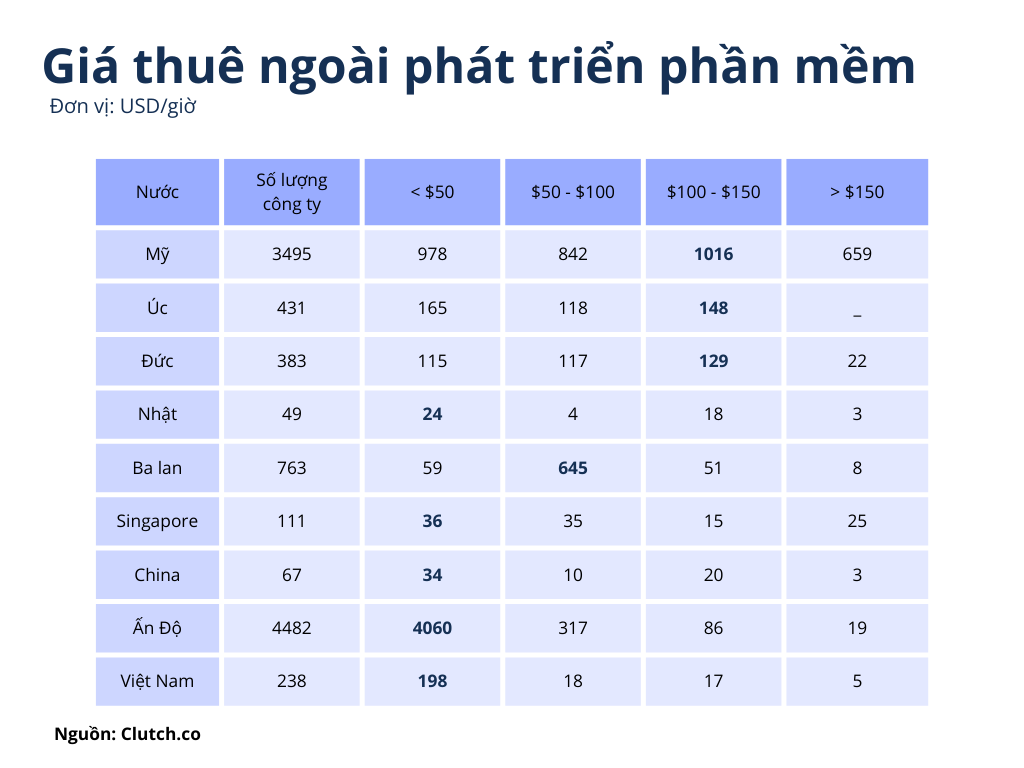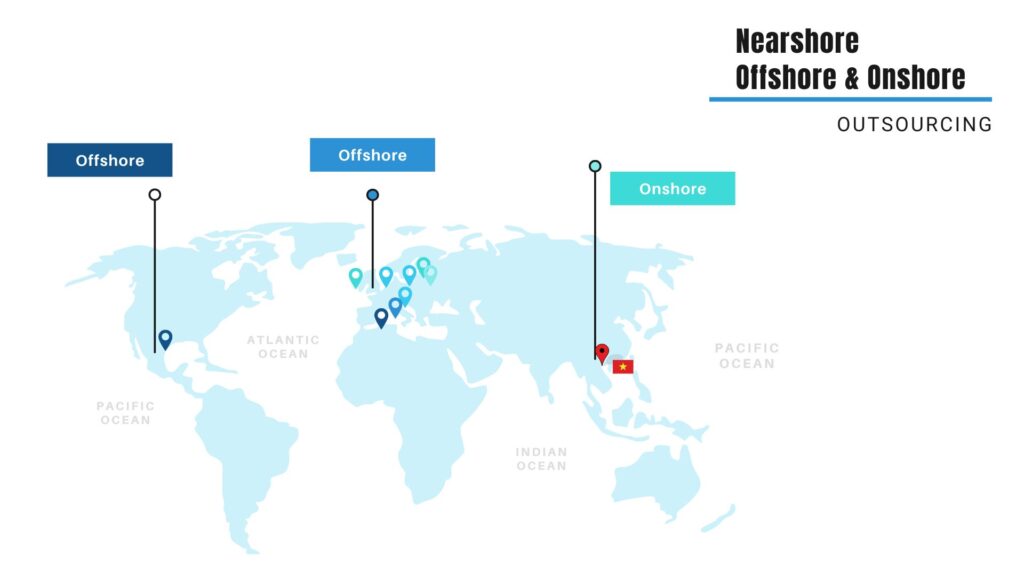When businesses embark on software development projects, they often confront the decision of selecting the most suitable software development model that aligns with their requirements and budget. Three commonly considered models are Nearshore, Offshore, and Onshore, each offering distinct advantages and disadvantages concerning geographical proximity, labor expenses, communication capabilities, and project management.
In this article, we will delve into the definitions, characteristics, and comparative analysis of the Nearshore, Offshore, and Onshore models. By doing so, we aim to assist businesses in making informed decisions regarding the selection of a software development model that best fits their business needs and product development strategy
Concept of Nearshore, Offshore & Onshore software development
Nearshore
The Nearshore model involves software development in a country geographically close to the client’s home country. For instance, a US-based company may opt to hire software developers from Mexico or Canada to work on its product. This model offers cost savings compared to hiring domestic developers, while communication and project management are facilitated due to the proximity of the development team.
Offshore
The Offshore model entails software development in a country significantly distant from the client’s home country. For example, an American company might engage a software development team in countries like India, Vietnam, or the Philippines to capitalize on lower labor costs. While this model offers cost advantages, it can present challenges in communication and project management due to the geographical distance.
Onshore
The Onshore model involves software development conducted within the client’s home country. For instance, a US-based company may hire American developers to work on its software projects. While this model offers convenience in communication and project management, development costs tend to be higher compared to the Nearshore and Offshore models.
Difference between Nearshore, Offshore & Onshore Outsourcing
1.Price
Onshore typically incurs the highest labor costs due to higher salaries for software engineers in developed countries like the US, Europe, and Japan. For instance, the average monthly salary for a programmer in the US ranges from $5000-7000, while in Vietnam, it’s approximately $1000-1500.
Offshore offers the most cost-effective labor rates as IT staff in developing countries earn considerably less than their counterparts in developed nations. For instance, workers in countries like Vietnam, the Philippines, and India receive salaries that are only 1/3 to 1/5 of those in the US.
Nearshore falls between Onshore and Offshore in terms of costs. The closer geographical proximity reduces shipping costs and import taxes, contributing to a moderate cost level.

2. Legal and Tax System
Geographic distance not only affects costs but also impacts the legal and tax systems. Finding an overseas service provider requires a thorough understanding of the necessary legal regulations.
Onshore benefits from operating within the same country as the customer, ensuring uniformity in legal systems and tax policies. This minimizes legal risks related to labor issues, intellectual property, contract signing, and dispute resolution. Legal risks are at a minimum.
Nearshore experiences similarities in legal systems due to close geographical distances. For instance, countries like Mexico, Canada, and the United States share market economies with similar legal foundations, reducing legal risks. Bilateral and regional agreements also create uniformity in tax and customs policies. Legal risks are low.
Offshore faces significant differences in laws and taxes, particularly when the customer is in developed countries and the supplier is in developing nations. Variations in labor regimes, intellectual property laws, and legal procedures pose higher potential risks, along with changing tax incentive policies. In addition, tax incentive policies may change over time. Therefore, legal risks are at the highest level.
3. Distance
The geographical separation between the customer and the service provider is a critical consideration in outsourcing. Proximity plays a significant role in facilitating face-to-face interactions, which can greatly enhance the software development process
In the Onshore model, the geographical distance between customers and suppliers is minimal, often within the same country or just a few hundred kilometers apart. This close proximity enables frequent in-person meetings, allowing parties to easily visit and discuss the project. For example, a client company in New York might regularly travel to Boston for weekly meetings with the development team.
Under the Nearshore model, the geographical distance is greater, spanning several thousand kilometers and requiring 1-4 hours of flight time. While face-to-face meetings are less frequent compared to the Onshore model, they are still feasible. For instance, a company in the US may have a supplier in Mexico, facilitating meetings every 1-2 months.
In contrast, the Offshore model involves significant distances, typically requiring 8-16 hours of flight time. Face-to-face meetings are rare and usually reserved for crucial occasions, such as signing major contracts For example, an American company collaborating with an Indian or Vietnamese supplier may only meet in person for significant milestones.
However, advancements in technology have mitigated the impact of distance, enabling effective communication and collaboration even across vast distances. Therefore, while distance remains a factor to consider, it is no longer a major barrier to outsourcing globally.
4. Time Zone
In the Onshore model, both the supplier and the customer share the same time zone since they operate within the same country. This alignment facilitates seamless exchange of information, coordination of work, and prompt decision-making. Online or in-person meetings can be easily scheduled during standard office hours, enhancing efficiency.
Under the Nearshore model, there typically exists a slight time difference of 1-3 hours between the customer and the supplier. Despite this difference, it has minimal impact on daily coordination efforts. Parties can still convene convenient online meetings within regular business hours, ensuring effective communication.
Conversely, the Offshore model entails a considerable time zone gap, ranging from 6-12 hours. This disparity necessitates greater flexibility in work schedules, often requiring parties to extend their working hours to accommodate communication across different time zones.

Managing multiple time zones can pose challenges to coordination efforts. However, modern flexibility and remote work tools offer effective solutions to mitigate these challenges, enabling efficient communication and collaboration irrespective of geographical differences.
5. Language
Language disparities can pose significant challenges to communication and development processes in outsourcing. Domestic outsourcing offers the advantage of utilizing the same language, reducing the likelihood of miscommunication. However, effective communication systems are crucial regardless of language.
In the Onshore model, both suppliers and customers communicate in the same language, typically the mother tongue of both parties. This facilitates convenient and direct communication, minimizing the risk of misunderstandings or misinformation.
Under the Nearshore model, parties often use a common language such as English or a language accepted by the customer. Overseas suppliers usually possess proficient foreign language skills to meet customer requirements, resulting in a low language barrier risk.
Conversely, the Offshore model presents greater language challenges as the supplier’s language may differ significantly from the customer’s. Measures such as language training and hiring interpreters are necessary to mitigate the high risk of misunderstandings.
English has emerged as the predominant business language globally. Many software outsourcing companies in countries like Poland, the Philippines, and Vietnam have invested in training their employees to achieve fluency in English. This proactive approach helps overcome language barriers, fulfilling communication and project development needs.
In conclusion, language differences are no longer a significant obstacle for software outsourcing companies today, thanks to the widespread adoption of English and efforts to enhance language proficiency among employees.
6. Culture
Understanding and appreciating cultural differences play a vital role in the success or failure of software development projects. When considering software development models such as Onshore, Nearshore, and Offshore, it’s essential to recognize that cultural dynamics influence how teams collaborate and communicate, not just technical skills and cost considerations.
In the Onshore model, where the development team and the customer share the same culture, there is a natural alignment that facilitates mutual understanding. Cultural similarity reduces ambiguity in interpreting customer requirements and expectations, thus enhancing the likelihood of project success.
The Nearshore model, characterized by greater cultural similarity compared to Offshore due to closer geographical proximity, also benefits from enhanced communication and understanding. Despite some minor cultural differences, the geographical closeness enables seamless integration and collaboration, minimizing the risk of misunderstandings and conflicts.
Conversely, the Offshore model, with the widest cultural gap, often encounters challenges during the working process. Cultural disparities can lead to misunderstandings and conflicts in interpreting requirements and communicating effectively, resulting in reduced productivity and increased project failure risk.
To thrive in a multicultural software development environment, leveraging and understanding cultural similarities are crucial. Whether operating Onshore, Nearshore, or Offshore, effectively managing cultural diversity within the team fosters a positive work environment and enhances the likelihood of software development project success.
Conclusion
| Criteria | Onshore | Nearshore | Offshore |
| Expense | Highest | Medium | Lowest |
| Law and taxes | Identical | Similar | Different |
| Distance | Nearest | Nearby | Furthest |
| Time zone | Identical | Small difference | Big difference |
| Languages | Identical | Similar | Different |
| Culture | Identical | Similar | Different |
| Direct Communication | Most often | Occasionally | Seldom |
| Legal risks | Lowest | Medium | Highest |
Vietnam: An Ideal Destination for Global Software Outsourcing
Vietnam stands out as an exceptional destination for international businesses seeking software outsourcing solutions, thanks to a combination of factors including competitive costs, high-quality human resources, a stable business environment, strategic geographical location, and supportive government policies.
- Competitive Costs: Vietnam maintains lower labor wages and production costs compared to many developed countries, offering a cost-effective advantage for international businesses considering software outsourcing.
- Quality Human Resources: With a young and skilled workforce, particularly in the information technology sector, Vietnam produces thousands of IT engineers annually from its universities and colleges, ensuring a steady supply of high-quality talent for the software industry.
- Stable Business Environment: The Vietnamese Government actively promotes software industry development through supportive policies, tax incentives, and favorable conditions for businesses operating in the sector, fostering a stable and conducive business environment.
- Strategic Geographical Location: Situated in the heart of Southeast Asia and the Asia-Pacific region, Vietnam provides convenient access to major markets such as ASEAN, China, Japan, and Korea, offering geographical advantages for collaboration and communication with international partners, including European businesses.
- Preferential Policies: Continual support and incentive policies from the Vietnamese government, encompassing investments, tax benefits, and infrastructure assistance, further enhance the attractiveness of Vietnam as a software outsourcing destination.
- Development Potential: The information technology and software market in Vietnam are experiencing robust growth, showcasing significant potential to emerge as a leading technology hub in the region, presenting abundant opportunities for international businesses.


 日本語
日本語 한국어
한국어 Tiếng Việt
Tiếng Việt 简体中文
简体中文